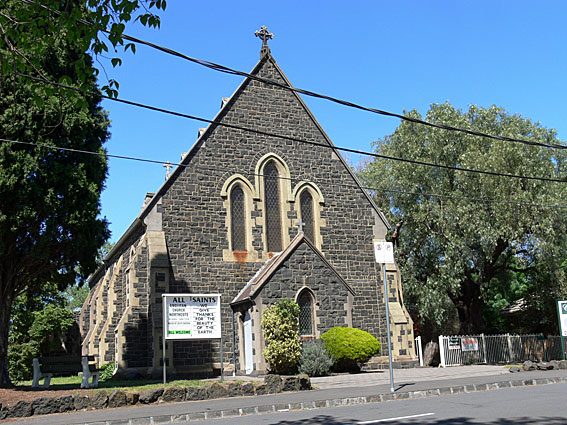
All Saints' Anglican Church, Northcote
[Photograph by John Maidment (October 2009)]

All Saints' Anglican Church, Northcote
[Photograph by John Maidment (October 2009)]
Historical and Technical Documentation by John Maidment
© OHTA 2009, 2015 (last updated May 2015)
All Saints' Church was built in 1859-60 to the design of Nathaniel Billing, although it was never completed. It is in the Early English Gothic style, and distinguished by the use of Bacchus Marsh freestone dressings on a body of squared snecked bluestone rubble.1
The first recorded location of the organ now at All Saints' Church dates back to March 1867 when it is shown in an engraving in the Illustrated Melbourne Post of 27 March 1867 depicting a flower show at the Prahran Town Hall. The organ is located on a gallery at the rear of the hall and its very distinctive case of four flats and top capped by a cornice and broken pediment is shown, together with an organist and young man at the blowing handle. Mr David Lee gave an organ performance on 23 March 1867 according to an advertisement in the Melbourne newspaper The Argus of that day.2 There are no further references to the organ in that location.
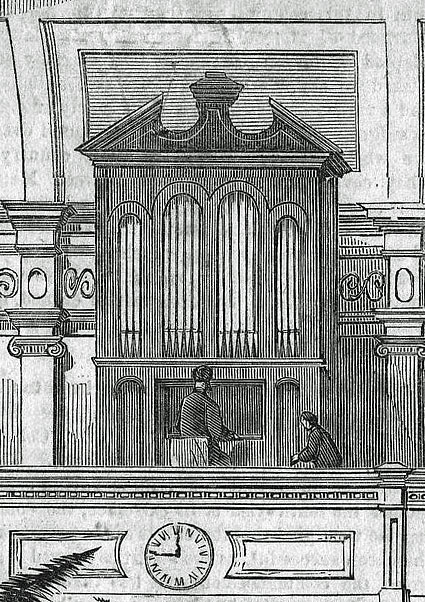
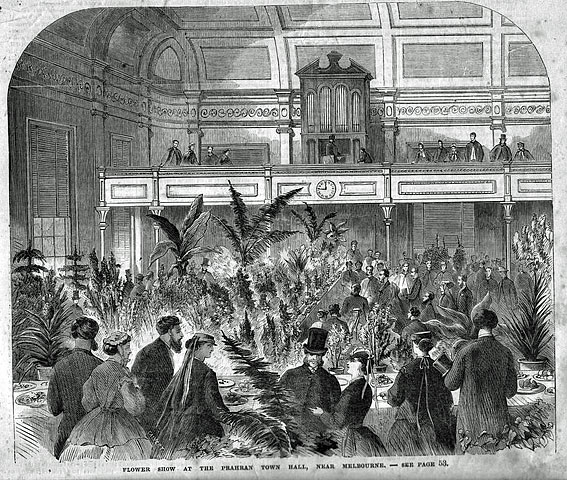
The William Anderson organ in the Prahran Town Hall
[Engraving from Illustrated Melbourne Post (27 March 1867)]
It is very likely that this is the organ that was opened on 2 December 1870 at the Wesleyan (Methodist) Church, Punt Road, South Yarra, not far away from the Prahran Town Hall. The Argus of 3 December 1870 reported:
The inauguration of a new organ, built for the Wesleyan Church, Punt-road, South Yarra, took place last night, when a concert of sacred music was performed in the church. Mr. C. E. Horsley presided at the new instrument, and performed five solos, well calculated to test its powers, which appeared well adapted for the size of the building. A slight hardness, probably due to the newness of the instrument, was apparent, but on the whole the audience seemed well pleased with the acquisition. It was built by Mr. Anderson, of South Yarra, and there is still £80 owing upon it, which amount, however, is expected to be made up in subscriptions, as a year has been allowed in which to clear off the debt. The proceeds of last night's concert are to go towards liquidating the debt, amounting to about £30, owing for the organ case - a handsome structure of stained Huon pine wood, with Gothic top and gilt pipes.3
On 25 July 1883 a larger organ at South Yarra, built by George Fincham, was opened. At All Saints' Church, Northcote, a new organ was opened on 7 June 1883 by G.H. Davies.
The Argus of 9 June 1883 reported:
A special service was held at All Saints Church, Northcote, on Thursday evening inst, to celebrate the opening of a new organ built by Mr. Anderson, of Little Flinders-street. The Bishop of Melbourne preached, and the discourse was listened to by the large congregation present with marked attention. The organ is a nice instrument, consisting of one manual, six stops to the great, also as solo stops the keraulophon and clarabella, separate bourdon pedal organ, and composition pedals. Mr. G.H. Davies, the organist of the church, fully brought out the beauties of the instrument, and the choir gave a very fair rendering of Bridgewater's Service, the anthem chosen being G.B. Allen's anthem "In the Beginning" in which the solo was tastefully sung by the leading soprano.4
George Fincham had quoted to supply an organ for the Northcote church in February 1883,5 but the instrument opened in June 1883 was clearly built by William Anderson. It seems almost unquestionable that this is the same organ as that used at South Yarra as it appeared at Northcote at the same time as it was removed from the South Yarra church. It is certain, however, that it is the organ used at Prahran Town Hall in 1867 as the casework, shown in a postcard of c.1950 of the Northcote interior, is identical.
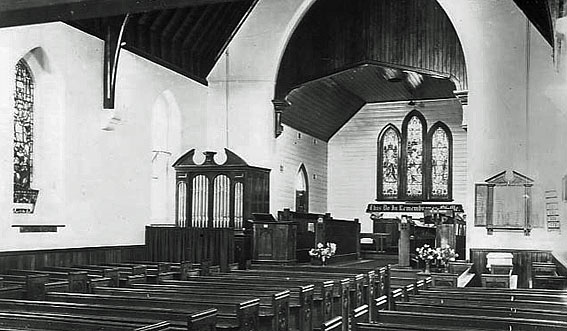
The William Anderson organ in All Saints' Anglican Church, Northcote
[Postcard from Darebin Historical Society (c.1950)]
The Northcote organ is clearly the earliest surviving example of William Anderson's work (dating from as early as 1866 when he was 34 years of age) and likely to have been the first organ he built. It is thus a very rare example of indigenous organbuilding of the period before 1870. There are few comparable examples of the period, only a few instruments by George Fincham and the James Moyle organ now at St Linus' Anglican Church, Merlynston from the mid-1850s.
Initially located at Northcote at the north-east corner of the nave, it was moved in the 1960s to the rear gallery where it was centrally placed at right angles to the gallery front. At this time, very sadly, the splendid casework with its broken pediment was removed. The wooden cover for the console has also been removed together with the wooden keyslip. It is understood that these may be in storage and it is highly desirable that they be replaced so that the overall integrity of the organ can be re-established.
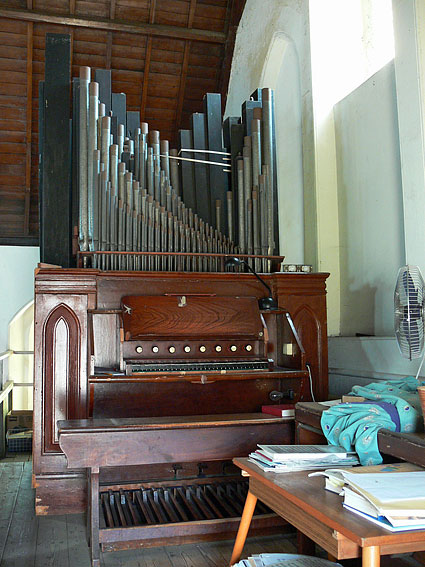

The William Anderson organ stripped of its original casework
and re-located to the rear gallery at All Saints' Church
[Photographs by John Maidment (October 2009)]
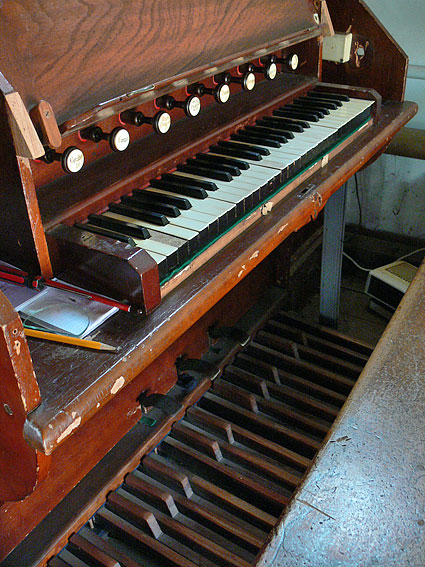
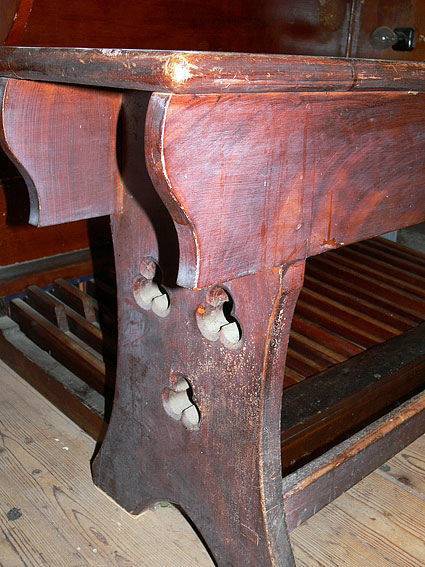
Console and bench of the William Anderson organ
[Photographs by John Maidment (October 2009)]
| MANUAL Open Diapason Stop Diapason Bass Clarabell Keraulophon Principal Fifteenth Coupler PEDAL Bourdon |
8 8 8 8 4 2 16 |
CC-BB open wood TC spotted metal CC-TE TF TF, bottom 2 pipes stopped wood, remainder black metal with keyhole slots spotted metal black metal |
Compass: 56/29
3 composition pedals
Mechanical key & stop action
Metal pipework fitted with tuning slides
Electric blower
No evidence of swell box.6
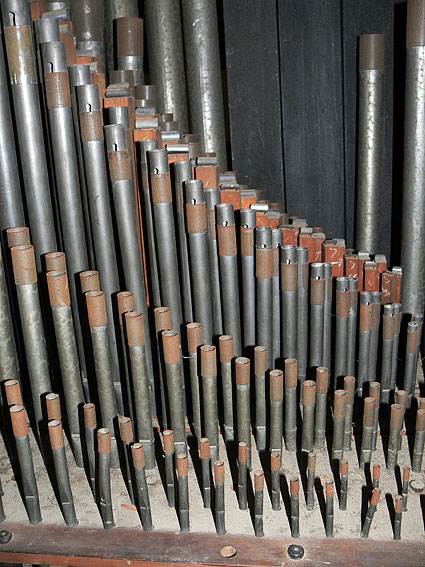
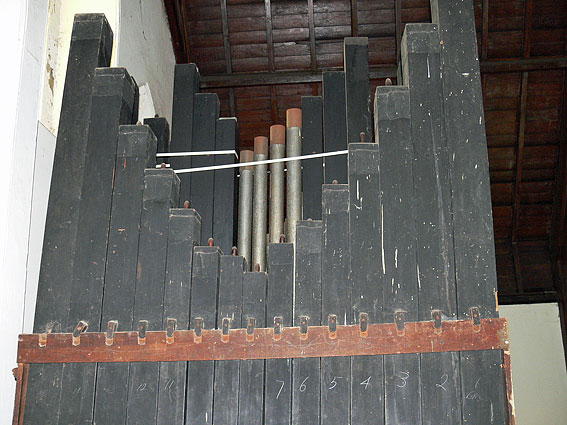
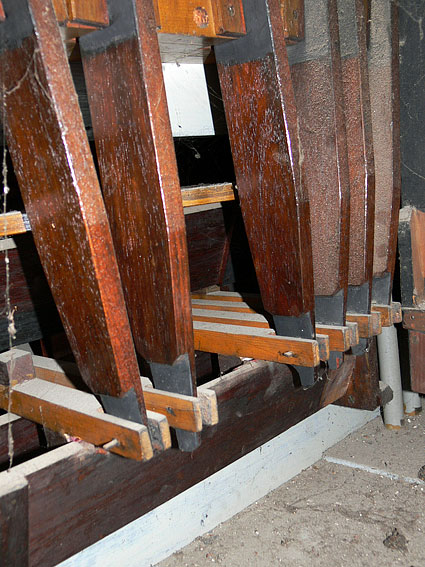
Pipework and stop action
[Photographs by John Maidment (October 2009)]
The whole instrument merits a complete and sensitive professional restoration although it must be said that it still works admirably and the pipework is in a reasonable state and notable for its very forthright sound in a fine acoustic.
1 Miles Lewis (ed.), Victorian Churches: Their origins, their story & their architecture (Melbourne: National Trust of Australia (Vic.), 1991), p. 77.
2 The Argus (23 March 1867), p. 8.
3 The Argus (3 December 1870), p. 5.
4 The Argus (9 June 1883), p. 9.
5 George Fincham Letter Book (Specification Book), vol. 13, pp. 152-53 (13 February 1883).
6 Specification noted by John Maidment, October 2009.